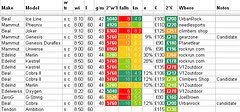 Imagine waking up at 2 a.m. to the sound of a screaming smoke alarm. Would you go back to bed? Of course not! You’re scrambling to get up and get the family out of the house as fast as possible!
Imagine waking up at 2 a.m. to the sound of a screaming smoke alarm. Would you go back to bed? Of course not! You’re scrambling to get up and get the family out of the house as fast as possible!
Now, let’s compare that smoke alarm to your Business Intelligence (BI). Like a smoke alarm, a BI solution gathers data and alerts you to issues–but it ultimately falls on you to take action. This is where many businesses stumble. They either ignore the signals from their BI solution, or aren’t prepared to act when an issue arises. It’s like going back to bed when you hear the smoke alarm, or removing the battery so it won’t wake you up anymore.
I know that’s an extreme example, but it illustrates just one common “worst practice” of BI–a topic that we’re going to examine today. Now, chances are, you understand the concept and the value of BI. It helps you better understand your business and improves decision making, with the end goal of increased revenue.
The problem is, many businesses misuse BI, rendering their Business Intelligence either less effective or completely ineffective. What are these mistakes, and how can you avoid them? To help you answer those questions, I’ve compiled a list of 7 of the biggest “worst practices” of Business Intelligence, and outlined them below:
1. Using BI to justify a pre-existing position
Many people use BI backwards. They make their decision first, and then go back and find data that justifies their decision. This is a mistake…and negates the entire purpose of BI.
“Companies should avoid using BI outcomes to justify and underscore pre-existing positions,” says Craig Fryar, Head of Global Business Intelligence at Wargaming. “By doing so they just add a little analytical gravy as they consume their own dog food. Related to this is the tendency to use outcomes to reinforce competing agendas. It is important to remember that most often the competition is down the street, not down the hall.”
2. Measuring unactionable data (or failing to take action)
“Regarding business intel mistakes, one of the biggest is to not think through responsiveness–how well your organization can respond to the new information,” explains Matt Gershoff, CEO and Co-Founder of Conductrics. “If you think about it, value comes about after data is converted to information, and the information is then converted to action. If you are not agile enough to act, you won’t see any upside.”
Now, you’ll find two types of unactionable data. First, you have actionable data that your company isn’t prepared to act on–as Gershoff describes above. Second, you have data that cannot drive action. Often referred to as “vanity metrics”, this data might make you feel good, but doesn’t lead to change. Before you measure any metric, ask yourself, “What are we going to do about this?”
3. Using Excel as a BI tool
Unfortunately, MS Excel is still the most commonly used “BI tool” in businesses today. I put that in quotation marks because I wouldn’t classify Excel as a BI tool. What’s so wrong with Excel? Here are a few reasons it should be avoided:

- It’s inefficient: Pulling data out of your system and then formatting/manipulating that data is time consuming, often requiring hours (or even days) of work. A true BI tool puts the data at your fingertips, giving you instant access to actionable data without much extra effort on your part.
- It’s insecure: With a spreadsheet, you can’t control user access. You can’t control who shares it with whom. You don’t know how many people have edited a single document. You can’t even control how many versions of a single spreadsheet exist–or which one is current. Do you want your business data floating around in spreadsheets, completely out of your control? I don’t.
- It leads to data errors: The more people with access to a spreadsheet, the greater the chances for mistakes. One study estimated that 80% of spreadsheets contain significant errors. Do you want to base business decisions off of a spreadsheet that an unknown amount of users could’ve accessed and edited? I sure don’t.
4. Failing to incorporate automation
Taking action on your BI data is good. Letting that data take action for you is better. Imagine if your BI software sent you an email or sms message when certain data reached a pre-defined level? Isn’t that so much simpler than doing everything manually? Of course! If you’re ignoring automation with your BI, you’re wasting a lot of time.
“While having pretty dashboards for every little metric you can wrap your head around can add some value, the real value is in what you can do with that data,” explains Kevin Lindquist, Director of Sales and Marketing for Decisions. “Before you write that insight off as cliché, consider what you could automate with all of that data. Inventory getting low at one location? Prepare an order for approval and when the simple email is approved by the manager, the order is automatically processed. Sales figures in one region in a slump? Right click on that chart and start a call with that region’s manager.”
5. Over-emphasizing forecasting (at the expense of understanding)

Improved decision-making is the goal of BI. It gives you a better understanding of your business, and helps shape future decisions. However, some make the mistake of using BI as a forecasting tool without spending the time to truly understand the data. For instance, you can’t look at sales data and forecast a 10% increase without understanding what truly drives those sales.
“Forecasting is indeed important if it affects how you allocate resources,” says Chris Grant, Director of Analytics at Enlighten. “But spending a lot of time being able to forecast that “six months from now we will have xxx visitors on the site” is not very useful except for making yourself look like a genius if you’re right. Rather than trying to do that kind of forecast, you’d be better served spending the same analysis energy trying to understand things like which kinds of email content produce a big return, and better yet, what is going on in the consumer’s mind when they decide whether to respond to that email. Then you have something you can use going forward, to increase success. You’re getting information that will help you be better. In other words, a lot of forecasting is just an exercise to go through to make management feel like there’s some control … without actually achieving better control.”
6. Failing to empower the business
“A major mistake that businesses make includes failing to empower the business, says Kevin Walker, VP of Sales and Marketing at Manthan Systems. “Decisions are made across the enterprise, at every level in the organization, every day. Of course, many decisions are routine and can be automated. However, many decisions require complex analytics. If a standard business user cannot use the BI system for ad hoc queries and advanced analysis, then the BI project cannot be considered a success.”
He brings up an all too common problem: In many businesses, all BI and reporting goes through the IT department. Do end users in your company still rely on your IT department for BI or reporting? Stop and consider just how much time that wastes. Not only must your end users wait days (or sometimes weeks) for necessary information, it pulls your IT department away from other, mission-critical tasks. Instead, give end users the appropriate tools to create their own reports and BI apps.
7. Failing to identify a business champion
What’s one of the biggest problems plaguing BI implementations? User adoption (or a lack thereof). While the reasons vary, the failure to involve the business and identify an executive-level champion to drive the implementation on the business side ranks as one of the biggest reasons for BI failure.
“Some companies only include the IT organization in the project planning process,” explains Walker. “Some companies fail to identify a senior executive-level sponsor and “champions” within the various business units. This results in a lack of adoption throughout the business, sometimes because true business requirements are not captured during the implementation process or because the company hasn’t approached change management.”
Wrap up
As businesses collect more and more data, BI becomes even more important. However, misusing BI can not only decrease its effectiveness, it can completely negate its purpose. While the reasons listed above aren’t a comprehensive “worst practices” list by any means, I believe they are some of the most important areas to avoid.
Would you add anything to the list?
I was on board with the first few items until I got to using Excel as a BI tool. While Excel in its native form does have some issues, with addins such as PowerPivot, PowerView, and Data Mining the bullet point is very misleading as Excel can be just as powerful as tools like QlikView.
Anthony–
I agree that Excel is useful for BI, but with a HUGE caveat: only as long as a spreadsheet is used by a single person. But, in my experience, it’s seldom used by a single person. That’s where the problems start. When it turns into a multi-person or multi-department tool, it wreaks havoc. I’ve wasted hours of time in the past correcting spreadsheets that others have broken. In one instance, a new employee accidentally sorted a spreadsheet by a single column, and didn’t recognize her mistake for 2 days. When she finally realized there was a problem, the spreadsheet was ruined (and it was important). She quit the next day.
I think that’s more of what the article is referring to. If spreadsheets are used as a multi-person BI tool (which they often are), they’re insecure and likely to contain errors.